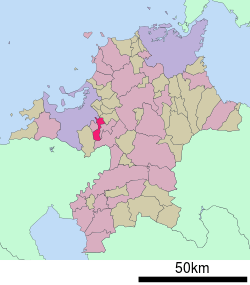Ōnojō
| Ōnojō 大野城市 | ||
|---|---|---|
| City | ||
| ||
 Location of Ōnojō in Fukuoka Prefecture | ||
 Ōnojō Location in Japan | ||
| Coordinates: 33°32′N 130°29′E / 33.533°N 130.483°ECoordinates: 33°32′N 130°29′E / 33.533°N 130.483°E | ||
| Country | Japan | |
| Region | Kyushu | |
| Prefecture | Fukuoka Prefecture | |
| Government | ||
| • Mayor | Muneji Imoto | |
| Area | ||
| • Total | 26.89 km2 (10.38 sq mi) | |
| Population (September 30, 2016) | ||
| • Total | 99,965 | |
| • Density | 3,717.65/km2 (9,628.7/sq mi) | |
| Symbols | ||
| • Tree | Round leaf holly | |
| • Flower | Chinese bellflower | |
| Time zone | Japan Standard Time (UTC+9) | |
| City hall address |
2-2-1, Akebonomachi, Ōnojō-shi, Fukuoka-ken 816-8510 | |
| Website |
www | |
Ōnojō (大野城市 Ōnojō-shi) is an area located in Fukuoka Prefecture, Japan. Its name is made up of the kanji for 'big', 'field', and 'castle'. It is mostly a southern suburb of the city of Fukuoka, and has a border to the northwest with the Hakata-ku area of the city. It also shares borders with Dazaifu and Kasuga, Umi, Chikushino, Nakagawa and Shime. The border with Umi is marked by the summit of Otoganayama at 268 metres above sea level, a wide expanse of deciduous and bamboo forest, uninhabited except by the occasional snake. The Mikasa river flows through Ōnojō on its way to Hakata bay, with some of its tributaries such as Cow neck river originating in the mountains in the south. Ducks, turtles, koi, egrets, herons and Japanese wagtails can be seen in or around the river, depending on the season.
As of September 30, 2016, the city has an estimated population of 99,965 and a population density of 3,717.55 persons per km2. The total area is 26.89 km2.
The city was founded on April 1, 1972. The city flower is the Chinese bellflower, known in Japanese as kikyō.
JR Kyushu has a railway station named Ōnojō, five stops south of Hakata Station on the Kagoshima Main Line. JR Mizuki Station is on the south-eastern edge of Onojo. The Nishitetsu Tenjin Ōmuta Line also has two stations within Onojo. There are also Nishitetsu buses and local municipal buses.
There is a Daimonji festival in September, near the Madokapia culture centre, library and city office. Like other parts of Fukuoka, homeless people can be found sleeping in some of the parks. It has areas devoted to the mizu shobai. It also has many Shinto shrines and Buddhist temples.
At the beginning of the 21st century the area has seen continued real estate development partly due to good infrastructure, unlike more rural parts of the prefecture. Major retailers Seiyu Group[1] and Aeon have stores here, as do several conbini chains. However, in summer 2009 very heavy rain led to a mudslide, killing 2 people on the Kyushu Expressway.
Musician Aska is from Ōnojō, as is baseball player Yuichi Honda.
The city has a comprehensive recycling policy, but deforestation was continuing in 2011. Central Onojo is on the flight path to Fukuoka airport, so noise pollution can be a problem.
It is part of the fifth congressional district of Fukuoka Prefecture.
The city has constructed several walking routes, details of which can be found opposite the city library.
References
External links
| Wikimedia Commons has media related to Ōnojō, Fukuoka. |
- Ōnojō City official website (in Japanese)
